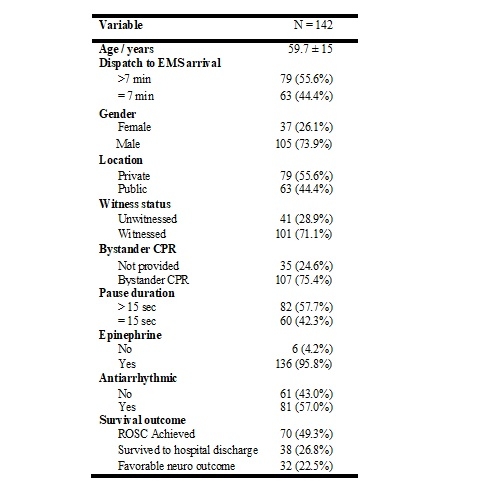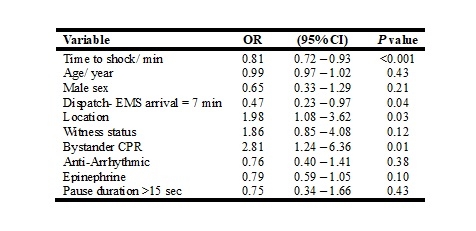Final ID: Su304
The Effect of Time to DC Shock on Return of Spontaneous Circulation in Out-of-Hospital Cardiac Arrest with Recurrent Shockable Rhythm
Abstract Body: Objective: The optimal timing for defibrillation attempts in out-of-hospital cardiac arrest (OHCA) patients with recurrent shockable rhythms [ventricular fibrillation (VF) or pulseless ventricular tachycardia (VT)] is uncertain. This study examined the association between "time to DC shock" and the return of spontaneous circulation (ROSC) in OHCA patients with recurrent shockable rhythms.
Methods: This was a retrospective analysis of data from the Salt Lake City Fire Department (SLCFD) from 2012 to 2023. Rhythm-filtering technology, used since 2012, enabled real-time and accurate interpretation of cardiac rhythms during CPR, with local protocols allowing early defibrillation for recurrent VF/ pulseless VT cases. Patients who experienced four or five episodes of shockable rhythms and received defibrillation were included. Generalized estimating equation (GEE) analysis was used to evaluate the association between time to shock preceding recurrent defibrillation and ROSC.
Results: A total of 142 patients were included, with a mean age of 59.7 ± 15 years; 105 (73.9%) were male, 63 (44.4%) arrested in public locations, and 101 (71.1%) had witnessed arrests. Adjusted GEE analysis revealed that longer time to shock was associated with lower odds of achieving ROSC (OR: 0.81, 95% CI: 0.72–0.93, p = 0.005). Every one-minute delay in defibrillation is predicted to decrease the likelihood of achieving ROSC by 19%.
Conclusion: In patients with recurrent shockable rhythms, every one-minute delay in delivering a shock was associated with a statistically significant 19% reduction in the chance of achieving ROSC. This finding highlights the importance of reducing the time to defibrillation in managing recurrent shockable rhythms and suggests reevaluating the current recommendation of two-minute intervals for rhythm check and shock delivery.
Methods: This was a retrospective analysis of data from the Salt Lake City Fire Department (SLCFD) from 2012 to 2023. Rhythm-filtering technology, used since 2012, enabled real-time and accurate interpretation of cardiac rhythms during CPR, with local protocols allowing early defibrillation for recurrent VF/ pulseless VT cases. Patients who experienced four or five episodes of shockable rhythms and received defibrillation were included. Generalized estimating equation (GEE) analysis was used to evaluate the association between time to shock preceding recurrent defibrillation and ROSC.
Results: A total of 142 patients were included, with a mean age of 59.7 ± 15 years; 105 (73.9%) were male, 63 (44.4%) arrested in public locations, and 101 (71.1%) had witnessed arrests. Adjusted GEE analysis revealed that longer time to shock was associated with lower odds of achieving ROSC (OR: 0.81, 95% CI: 0.72–0.93, p = 0.005). Every one-minute delay in defibrillation is predicted to decrease the likelihood of achieving ROSC by 19%.
Conclusion: In patients with recurrent shockable rhythms, every one-minute delay in delivering a shock was associated with a statistically significant 19% reduction in the chance of achieving ROSC. This finding highlights the importance of reducing the time to defibrillation in managing recurrent shockable rhythms and suggests reevaluating the current recommendation of two-minute intervals for rhythm check and shock delivery.
More abstracts on this topic:
A Predictive Score for In-Transit Cardiac Arrest in Trauma Patients: Development and Validation Using a National Registry
Nishida Tsubasa, Nishikimi Mitsuaki, Namba Takeshi, Ohshimo Shinichiro, Shime Nobuaki
Chest Compressions to the Left of the Sternum are Associated with Higher Systolic Blood Pressure than to the Lower SternumFrank Kevin, Cohen Allison, Haddad Ghania, Berruti Alaina, Li Timmy, Young Elizabeth, Becker Lance, Jafari Daniel, Rolston Daniel


